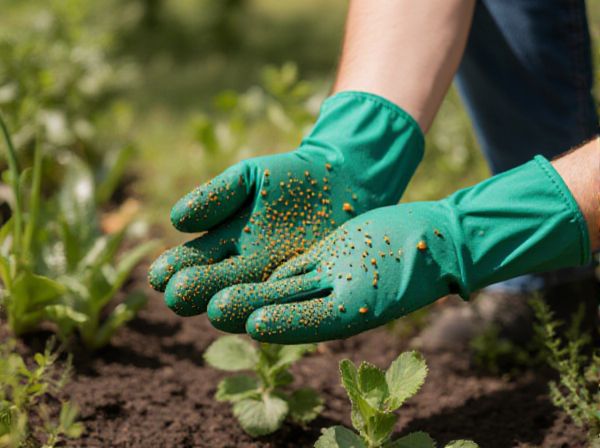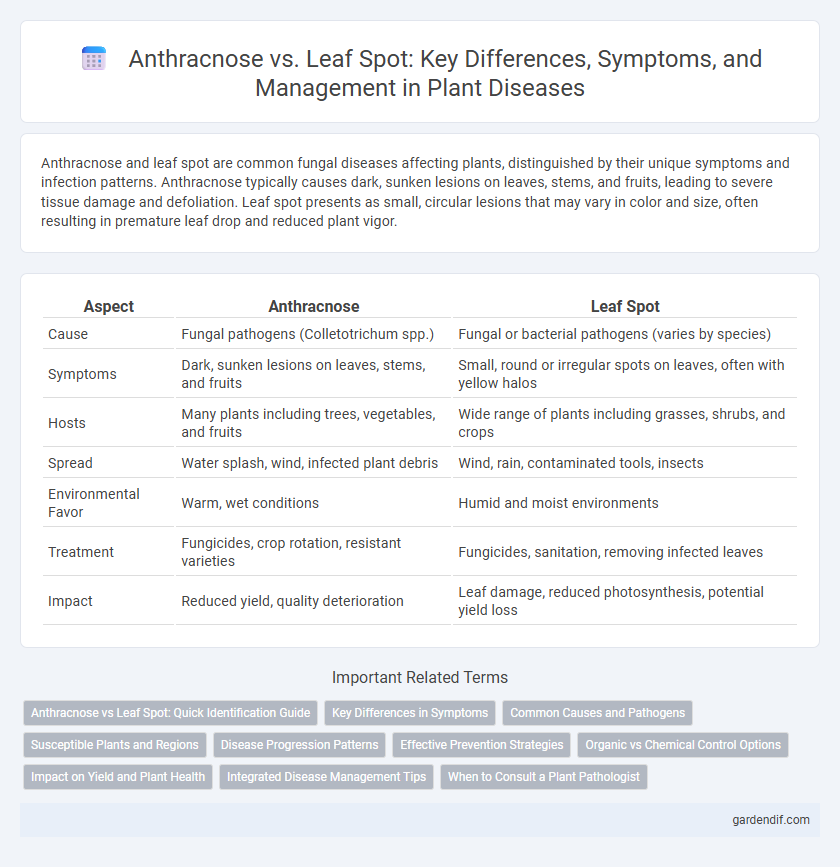
Anthracnose vs Leaf spot Illustration
Anthracnose and leaf spot are common fungal diseases affecting plants, distinguished by their unique symptoms and infection patterns. Anthracnose typically causes dark, sunken lesions on leaves, stems, and fruits, leading to severe tissue damage and defoliation. Leaf spot presents as small, circular lesions that may vary in color and size, often resulting in premature leaf drop and reduced plant vigor.
Table of Comparison
| Aspect | Anthracnose | Leaf Spot |
|---|---|---|
| Cause | Fungal pathogens (Colletotrichum spp.) | Fungal or bacterial pathogens (varies by species) |
| Symptoms | Dark, sunken lesions on leaves, stems, and fruits | Small, round or irregular spots on leaves, often with yellow halos |
| Hosts | Many plants including trees, vegetables, and fruits | Wide range of plants including grasses, shrubs, and crops |
| Spread | Water splash, wind, infected plant debris | Wind, rain, contaminated tools, insects |
| Environmental Favor | Warm, wet conditions | Humid and moist environments |
| Treatment | Fungicides, crop rotation, resistant varieties | Fungicides, sanitation, removing infected leaves |
| Impact | Reduced yield, quality deterioration | Leaf damage, reduced photosynthesis, potential yield loss |
Anthracnose vs Leaf Spot: Quick Identification Guide
Anthracnose causes irregular, sunken lesions with dark borders on leaves, while leaf spot typically presents as small, round, and distinct spots without raised edges. Anthracnose often leads to early leaf drop and can affect stems and fruit, unlike leaf spot which primarily targets foliage. Quick identification relies on lesion appearance and affected plant parts, crucial for effective disease management in crops.
Key Differences in Symptoms
Anthracnose typically causes irregular, dark brown to black necrotic lesions with distinct borders on leaves, often accompanied by leaf curling and dieback, whereas leaf spot diseases produce smaller, more uniform circular spots that can be tan, brown, or black with a chlorotic halo. Anthracnose symptoms often include stem cankers and fruit rot in addition to foliar damage, differentiating it from leaf spot, which primarily affects leaves without extensive tissue decay. Early detection of these symptom patterns is crucial for accurate diagnosis and effective disease management in crops.
Common Causes and Pathogens
Anthracnose is primarily caused by fungi in the Colletotrichum genus, leading to dark, sunken lesions on leaves, stems, and fruits, often exacerbated by warm, humid conditions. Leaf spot diseases are generally caused by a broader range of fungal pathogens, such as Cercospora, Alternaria, and Bipolaris species, resulting in distinctive round or irregularly shaped necrotic spots on foliage. Both diseases thrive in moist environments and significantly impact plant health by disrupting photosynthesis and weakening plant tissues.
Susceptible Plants and Regions
Anthracnose primarily affects hardwood trees such as oak, sycamore, and maple, thriving in humid regions of North America, Europe, and Asia. Leaf spot targets a broader range of plants including vegetables, ornamentals, and fruit trees, commonly occurring in temperate and tropical climates worldwide. Susceptibility varies with environmental conditions, favoring wet, warm areas that promote fungal growth and leaf tissue infection.
Disease Progression Patterns
Anthracnose typically initiates with small, water-soaked lesions that rapidly expand into irregular, dark necrotic spots, often coalescing and causing early leaf drop that accelerates under warm, humid conditions. Leaf spot diseases manifest as well-defined, circular to angular lesions with concentric rings or spots of varying colors, progressing more gradually but leading to widespread defoliation over time. Monitoring microclimatic factors like moisture and temperature is essential to differentiate the disease progression and implement timely management strategies for both anthracnose and leaf spot infections.
Effective Prevention Strategies
Anthracnose prevention relies on timely application of copper-based fungicides combined with proper sanitation practices such as removing infected plant debris to disrupt the pathogen's lifecycle. Leaf spot management focuses on improving air circulation through strategic plant spacing and pruning, alongside using resistant plant varieties to reduce susceptibility. Consistent monitoring and early intervention are critical in both diseases to minimize damage and prevent widespread outbreaks.
Organic vs Chemical Control Options
Anthracnose management in organic farming relies on cultural practices such as crop rotation, resistant cultivars, and copper-based fungicides, while chemical control often involves systemic fungicides like chlorothalonil and azoxystrobin for rapid disease suppression. Leaf spot diseases in organic systems are controlled using neem oil, sulfur applications, and maintaining proper plant spacing to reduce humidity, contrasting with chemical treatments that employ fungicides such as mancozeb or chlorothalonil for effective leaf spot elimination. Both diseases require an integrated approach tailored to organic standards or conventional chemical protocols to optimize plant health and yield.
Impact on Yield and Plant Health
Anthracnose causes severe defoliation and fruit rot, significantly reducing crop yield and weakening overall plant health through vascular damage. Leaf spot primarily leads to localized lesions that disrupt photosynthesis, resulting in moderate yield loss and diminished plant vigor. Both diseases compromise plant productivity, but anthracnose poses a more destructive threat due to its rapid spread and systemic impact.
Integrated Disease Management Tips
Anthracnose and leaf spot require precise integrated disease management strategies including regular monitoring, proper sanitation, and the use of resistant plant varieties. Applying fungicides at the early stages and ensuring adequate air circulation through pruning can significantly reduce disease incidence. Crop rotation and avoiding overhead irrigation further minimize favorable conditions for both Anthracnose and leaf spot pathogens.
When to Consult a Plant Pathologist
Consult a plant pathologist when anthracnose symptoms, such as dark, sunken lesions on leaves, stems, or fruits, rapidly worsen or spread extensively across the plant. Seek expert diagnosis if leaf spot causes irregular, discolored spots with uncertain origin, especially when standard treatments fail to control disease progression. Timely consultation ensures accurate identification and appropriate management strategies to prevent significant crop loss.
Anthracnose vs Leaf spot Infographic

 gardendif.com
gardendif.com